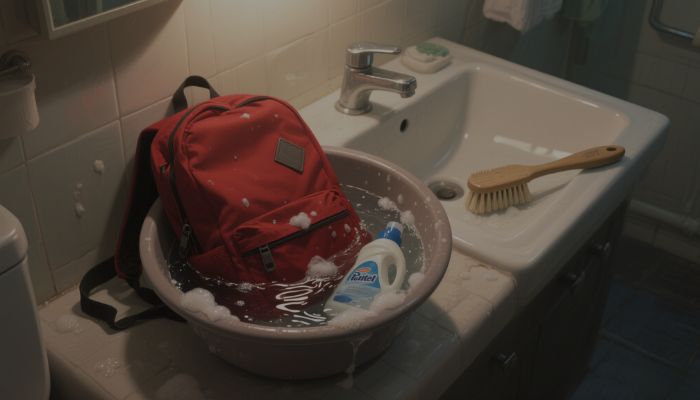Introduction: Why Backpack Odor Happens (and Why You Shouldn’t Ignore It)
Backpacks are trusted companions for school, work, travel, hiking, or daily commutes. But over time, they absorb moisture, dirt, sweat, and even bacteria. Left unchecked, these elements produce a strong, lingering odor that can be difficult to remove.
Many people simply toss in a dryer sheet, spray some perfume, or hang their bag near a sunny window. While these temporary fixes might mask the scent for a while, they don’t solve the root problem. Worse, they could damage the fabric or ruin waterproof linings.
If you’ve searched “how to get the smell out of your backpack,” chances are, you want a reliable, fabric-safe, and long-term solution. This article outlines five tried-and-true methods, each easy to apply and based on everyday items. You’ll also learn how to prevent odors in the first place with smart storage and regular care.
So if your backpack smells like old gym socks, mildew, or stale food—this guide is for you.
Section 1: White Vinegar Spray – Nature’s Deodorizer
When it comes to safe, effective, and natural cleaning agents, white vinegar tops the list. It’s antimicrobial, affordable, and easy to find. What’s more, it doesn’t just mask smells—it neutralizes them.
Why Vinegar Works
White vinegar contains acetic acid, a mild compound that kills bacteria and neutralizes alkaline odors. It’s especially effective against sweat, mildew, and pet smells. The beauty of vinegar is that it evaporates cleanly, leaving no lingering scent or residue.
How to Make the Spray
You’ll need:
-
1 cup white vinegar
-
2 cups water
-
1 empty spray bottle
-
Optional: a few drops of essential oil (like lemon or eucalyptus)
Instructions:
-
Mix the vinegar and water in the spray bottle.
-
Shake well.
-
Add essential oil for a fresher post-spray scent.
-
Lightly spray inside your backpack: lining, pockets, straps.
-
Allow it to air dry in a shaded, well-ventilated space.
Do not soak the fabric. A light misting is enough.
Safety Tips
-
Avoid colored vinegar—it may stain.
-
Don’t use it on leather or suede parts.
-
Always spot test first, especially for waterproof coatings.
This method is great for routine freshness or post-trip odor management.
Why It’s SEO-Friendly:
White vinegar is one of the most searched DIY cleaners. Phrases like “natural deodorizer,” “how to remove backpack smell without washing,” and “vinegar to clean backpack” are all LSI keywords that this section targets naturally.
Section 2: Baking Soda Soak – The Overnight Odor Eliminator
Baking soda, also known as sodium bicarbonate, is another household staple that packs serious odor-fighting power. It works not by masking smells, but by absorbing and neutralizing odor particles at a molecular level.
When to Use This Method
If your backpack has been in storage, got wet and dried, or smells musty despite washing—baking soda is your answer.
What You’ll Need
-
Baking soda (1/2 to 1 cup)
-
A large sealable bag or pillowcase
-
Vacuum cleaner or soft brush
Instructions
-
Empty your backpack.
-
Sprinkle a generous amount of baking soda inside the bag.
-
Place the bag inside a pillowcase or sealable plastic bag.
-
Let it sit overnight—at least 8–10 hours.
-
Shake out the powder and vacuum any remaining residue.
Why It Works
Baking soda is especially effective in absorbing moisture-based odors like mildew or stale fabric. It’s also safe for most materials, making it a universal cleaning hack.
Pro Tip: You can also leave a small sachet of baking soda in the bag between uses to keep it smelling fresh longer.
Additional Benefits
-
No water or drying time is required.
-
Great for winter when outdoor drying is tricky.
-
Completely non-toxic and safe for kids’ school bags.
Section 3: Sunlight and Airflow – The Forgotten Power Combo
Modern cleaning often overlooks the simplest solution: fresh air and sunlight.
Why It’s Effective
-
UV rays kill bacteria that cause odor.
-
Airflow helps dry out hidden moisture.
-
Heat and circulation speed up natural deodorization.
How to Do It Right
-
Choose a dry, breezy day.
-
Hang the backpack inside out if possible.
-
Place in partial sunlight (not direct noon sun).
-
Leave it out for 1–2 hours max.
Warning: Never leave your backpack under direct sunlight for long periods. Prolonged UV exposure can cause colors to fade and materials to break down, especially synthetic fabrics like nylon or polyester.
Best Use Cases
-
After hiking or gym use
-
Post-cleaning drying
-
Seasonal storage prep
This method is zero-cost and environmentally friendly. Combine it with other techniques for maximum freshness.
Section 4: Spot Cleaning with Gentle Detergents
Sometimes, odor comes from a specific spill or spot, like spilled coffee, leftover fruit, or even a leaking shampoo bottle. In these cases, a full wash isn’t needed—targeted spot cleaning is enough.
Supplies You’ll Need
-
A gentle detergent (non-bleach, pH neutral)
-
Warm water
-
A sponge or soft-bristled brush
-
Microfiber towel
Spot Cleaning Steps
-
Mix a few drops of detergent in warm water.
-
Dip the brush or sponge into the solution.
-
Gently scrub the affected area.
-
Wipe with a damp microfiber towel.
-
Air dry fully before use.
Areas to Focus On
-
Shoulder straps
-
Bottom panel
-
Interior seams
-
Under mesh linings
What to Avoid
-
Harsh scrubbing—can damage coatings
-
Soaking zippers—can rust or stick
-
Using hot water—can shrink some materials
This method works well for backpacks used in humid or tropical climates, where bacterial growth is rapid.
Section 5: Prevention Tips – Keep the Smell Away for Good
Once you’ve deodorized your backpack, the next step is to keep it that way.
Best Practices for a Fresh Backpack
1. Empty it regularly.
Don’t leave food wrappers, dirty clothes, or wet items inside.
2. Use dry pouches.
Store sweaty gym gear or toiletries in waterproof bags.
3. Add moisture absorbers.
Silica gel packs or activated charcoal sachets work wonders.
4. Store it in the right place.
Avoid damp closets or sealed plastic bins. Use open shelving with airflow.
5. Wash hands before handling.
It sounds small, but oils from hands can transfer over time.
Travel-Specific Tips
-
During multi-day hikes, open your backpack every night to air it out.
-
Avoid placing it on damp ground or near fire pits.
-
Clean it as soon as the trip ends—don’t procrastinate!
Bonus Tip: Use Essential Oils with Caution
You can add a cotton ball with essential oil to your bag for a mild scent. But avoid direct application—it may stain or irritate the skin.
Conclusion: A Clean Backpack = A Better Experience
No one wants to open their backpack and be hit with an unpleasant smell. Fortunately, it doesn’t take much effort to keep things fresh. With regular care and a few smart cleaning tricks, you can extend the life of your favorite pack and enjoy a better daily routine.
Remember: A clean backpack isn’t just about aesthetics—it’s about health, comfort, and peace of mind.
FAQs
Can I put my backpack in the washing machine?
Only if the care label says so. Most technical or outdoor backpacks should be hand-washed to protect fabric coatings and frame structures.
How often should I clean my backpack?
Light cleaning every month; deep cleaning every 3–6 months or after a trip.
Is Febreze or fabric spray okay to use?
Yes, but only occasionally. They mask odors rather than eliminate them and may contain alcohol or chemicals unsuitable for delicate fabrics.
What’s the fastest way to remove odor before a trip?
Use a vinegar spray, followed by a quick sun-air combo for 1 hour.
Can smells from mold be removed completely?
Yes—using baking soda and vinegar, followed by thorough drying. If mold is visible, spot treat immediately.




